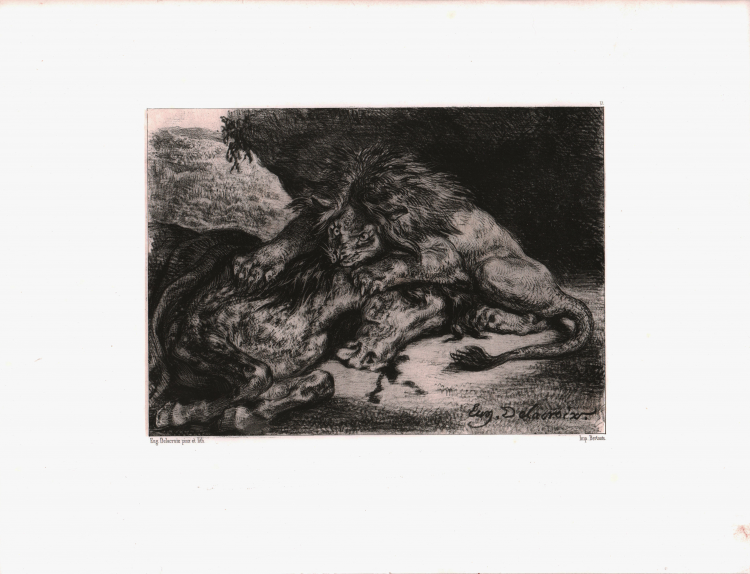



| Reference: | S42313 |
| Author | Ferdinand Victor Eugene DELACROIX |
| Year: | 1844 |
| Measures: | 265 x 190 mm |


| Reference: | S42313 |
| Author | Ferdinand Victor Eugene DELACROIX |
| Year: | 1844 |
| Measures: | 265 x 190 mm |
Lithograph, 1844, signed within the image: "Eug. Delacroix. "; lettered: "17" and with production line: "Eug. Delacroix pinx et lith." and "Imp.Bertauts."; blindstamped: "LES ARTISTES CONTEMPORAINS"
Fourth state, of five. Printed by Bertauts, Paris. Published by Goupil, Vibert & Cie., Paris for Les Artistes contemporains, with the blind stamp.
The scene depicts a male lion attacking the body of a horse near a rocky cave. Only the front portion of the horse is shown, lying on its side on the ground. The lion crouches above the horse and presses down with its front paws, claws extended, as it sinks its teeth into the horse's neck. There is a fierce, wild eyed expression on the lion's face. The scene is set in an undefined rocky landscape.
Delacroix traveled to North Africa in 1832, visiting Morocco and Algeria--a visit that fueled his interest in non-European cultures. The interest in exotic locales fascinated Europeans and coincided with the rise of tourism; painters (many of whom never left Europe) depicted distant places and different cultural settings, including harems. For the sophisticated and urbane Delacroix, the unleashed ferocity of wild animals--particularly the big cats--stirred his imagination. Scenes such as this of a lion attacking a horse figured frequently in Delacroix's art.
Eugène Delacroix (Charenton-Saint-Maurice 1798 - Parigi 1863), french painter, draughtsman and lithographer, was one of the towering figures of the Romantic movement and one of the last major artists to devote a large part of his career to mural painting in the heroic tradition. Lorenz Eitner (An Outline of 19th Century European Painting, 1987) describes him as ‘the last great European painter to use the repertory of humanistic art with conviction and originality. In his hands, antique myth and medieval history, Golgotha and the Barricade, Faust and Hamlet, Scott and Byron, tiger and Odalisque yielded images of equal power.’ He was the son of a diplomat, Charles Delacroix, who at the time of his son's birth was ambassador in The Hague, but it has been suggested that his natural father was the great statesman Talleyrand, a friend of the family. His mother, Victoire Oeben, was the daughter of Jean-François Oeben, one of the most distinguished furniture makers of his day. Delacroix had a good education and grew up with a love of literature and music as well as art. In 1815 he began studying with Pierre-Narcisse Guérin, who had earlier taught Géricault (whose work greatly influenced Delacroix), and the following year he enrolled at the École des Beaux-Arts. His real artistic education, however, was gained by copying Old Masters in the Louvre, where he delighted particularly in Rubens and the 16th-century Venetian painters. Throughout his life he remained a keen and perceptive student of his predecessors, and Rubens—with his richness of imagination, warmth of colour, and enormous energy—was a constant source of inspiration. In 1822 his career was brilliantly launched when his first submission to the Salon, the Barque of Dante (Louvre, Paris), a melodramatic scene from Dante's Inferno, was the talking point of the exhibition and was bought by the state. Two years later he had another success at the Salon with the Massacre at Chios (Louvre), inspired by a recent Turkish atrocity in the Greek War of Independence. It aroused much hostile criticism (Gros, who had admired the Barque of Dante, called it ‘the massacre of painting’), but it was awarded a gold medal and once again was bought by the state (with Talleyrand perhaps pulling strings in the background).
References
Delteil, Le Peintre-Graveur Illustré (XIXe et XXe siècles), 126, IV/V.
Ferdinand Victor Eugene DELACROIX (Charenton S.Maurice 1798 - Parigi 1863)
|
Eugene Delacroix is numbered among the greatest and most influential of French painters. He is most often classified as an artist of the Romantic school. His remarkable use of color was later to influence impressionist painters and even modern artists such as Pablo Picasso. Born in Charenton-St-Maurice, in 1815 he became the pupil of the French painter Pierre-Narcisse Guerin and began a career that would produce more than 850 paintings and great numbers of drawings, murals, and other works.
|
Ferdinand Victor Eugene DELACROIX (Charenton S.Maurice 1798 - Parigi 1863)
|
Eugene Delacroix is numbered among the greatest and most influential of French painters. He is most often classified as an artist of the Romantic school. His remarkable use of color was later to influence impressionist painters and even modern artists such as Pablo Picasso. Born in Charenton-St-Maurice, in 1815 he became the pupil of the French painter Pierre-Narcisse Guerin and began a career that would produce more than 850 paintings and great numbers of drawings, murals, and other works.
|